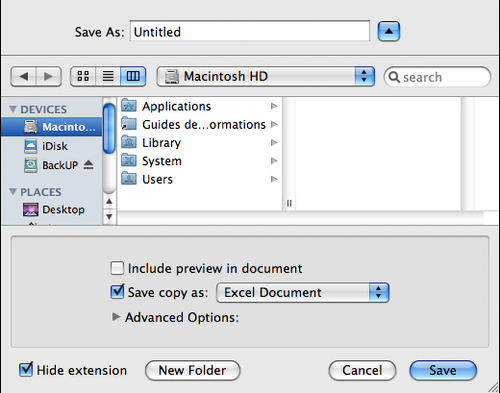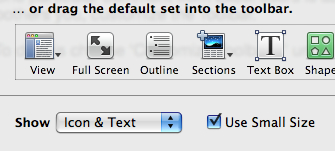The iWork spreadsheet application is Numbers. All basic operations, such as entering and editing data, applying formulas and functions, moving, adding and deleting cells, and selecting and hiding rows and columns, are virtually the same as in Excel, with just a few minor differences specific to how Mac operates. So, if you are already comfortable with using spreadsheets in MS Office or Open Office, you can go straight to Numbers and start using this application.
Let's see how Numbers can open Excel sheets and how Excel users can work with spreadsheets created in Numbers.
To open an Excel (or Open Office) document in Numbers, perform the following steps:
- Click on the Excel document and drag-and-drop onto the Numbers icon in the Dock.
The icon bounces while the program is being launched, and then the Excel spreadsheet opens as an iWork Numbers document.
Tip
To add a Numbers alias to the Dock, go to the Applications folder, open the iWork folder, click on the Numbers icon, and drag it to the Dock. Having the icon in the Dock allows quick direct access to a program that you use often. If you no longer use it often, click-and-drag it off the Dock. The alias disappears in a puff of simulated smoke, but the program itself stays in the Applications folder.
- Edit the spreadsheet in Numbers—add and change data, add, delete, or hide columns and rows, and apply functions. Once you have finished, save and send the document to your co-worker. If it has to be in Excel, you have several options:
- Under the Share menu, choose Send via Mail and choose Excel. The Mail application creates a new mail message with the Excel document already attached to it. Add the address, write a note, and send.

- Under Share, there is also an Export... option. This will create a new document in Excel, PDF, or CSV, that you can keep for backup and send to co-workers.
You can also find the Export option under the File menu, where it has been traditionally placed since the beginning of iWork. Click on it and choose Excel to create a backup copy of your Numbers spreadsheet in Excel or other formats.

- Under the Share menu, choose Send via Mail and choose Excel. The Mail application creates a new mail message with the Excel document already attached to it. Add the address, write a note, and send.
- Also, under the File menu, there is the usual Save As... option (the keyboard shortcut is Command + Shift + S). When the dialog window opens, check the Save copy as checkbox and choose Excel Document from the drop-down menu. Click on Save to get a duplicate of your Numbers spreadsheet in Excel format. Remember to save your document first in Numbers, otherwise it will be replaced by Excel.

In Numbers, tables and charts are separate objects placed on a canvas—which is a blank space—where they float and can be moved around with text boxes and graphic objects, which are added to create a very sophisticated document. When a Numbers document is exported to Excel, each of the objects is placed on a separate worksheet—if there are more than one. This doesn't affect your work; it's just something to get used to.
Excel users often comment that the icons in the Numbers toolbar are very small. If this bothers you, customize the toolbar to make the icons bigger.

To do this, choose Customize Toolbar... under the View menu, and uncheck Use Small Size at the bottom of the viewing options. Then, click on Done.
